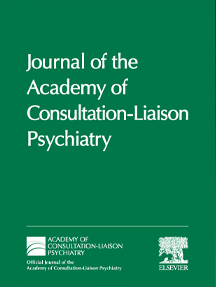[TOC-Bar-Wed-2018]
“The Need of the Hour”
New clinical pathways address the second leading cause of death worldwide
Among the host of ACLP stalwarts at this annual meeting contributing to the Breadth and Depth of Our Subspecialty you may well meet Maryland Pao, MD, FACLP.
 Maryland Pao, MD, FACLP
Maryland Pao, MD, FACLPDr Pao is a founding member of a workgroup that has generated the first clinical pathways to screen for suicide risk in pediatric hospitals— thereby addressing a pressing global crisis.
The facts
- Youth suicide is the second leading cause of death worldwide. In the US, more than 6,000 young people (under the age of 25 years) died by suicide in 2016.
- The suicide death rate for children aged 10 to 14 has surpassed the death rate from motor vehicle accidents.
- Eighty percent of young decedents by suicide visited a health care provider in the year before their death (40% visited a medical setting within the month before killing themselves.) “Medical settings are uniquely positioned for youth suicide prevention efforts,” say the workgroup.
- Suicide has remained in the top five most frequently reported sentinel events to the Joint Commission (JC). More than 1,000 patient deaths from suicide were reported from 2010 to 2014 during inpatient hospital stays or within 72 hours of discharge (including discharge from an emergency department).
Under-detection of suicide risk is considered a leading cause of these sentinel events, say the workgroup.
In 2007, the JC set forth National Patient Safety Goal 15.01.01, requiring suicide-risk screening for all behavioral health patients who present to psychiatric and general hospitals.
In 2016, the JC broadened its recommendations and issued Sentinel Event Alert (SEA) 56, recommending that all patients in medical hospitals, including those who present with non-behavioral health chief complaints, be screened for suicide risk using validated tools. Further, SEA 56 recommends establishing appropriate interventions and hospital support systems to address the risks found on screening.
“Successful implementation of screening requires senior leadership backing, tiered screening responses, management of outcomes, sufficient resources for managing positive screens, provider education, and clinical workflows,” say the workgroup.
Parkland Health and Hospital Systems, in Dallas, serves as a model for successful implementation of hospital-wide universal suicide-risk screening for both adults and youth, they say. Through thoughtful allocation of clinical resources, universal suicide-risk screening is managed effectively.
“This might be challenging for many individual hospital systems, including pediatric hospitals, given lack of requisite mental health experts and workflows, complicating efforts to successfully identify and treat patients who are at risk for suicide,” say the workgroup. Yet, “pediatric hospitals have used clinical pathways successfully to address similar limitations and concerns in asthma and antibiotic prescription.”
The workgroup
An international group of child and adolescent psychiatry C-L providers formed the Pathways in Clinical Care (PaCC) workgroup from within the Physically Ill Child Committee of the American Academy of Child and Adolescent Psychiatry. Many workgroup members are also members of the ACLP.
The goal of the Suicide Risk Screening PaCC subgroup was to create clinical pathways focused on early identification of suicide risk in pediatric patients who present to emergency departments and inpatient medical/surgical units.
Additional pathways in pediatric somatic symptom and related disorders and pediatric delirium will be released soon.
The suicide-risk screening pathway
The pathway includes the use of the Ask Suicide-Screening Questions (ASQ) (brief primary screener) and the Columbia Suicide Severity Rating Scale or the ASQ Brief Suicide Safety Assessment (secondary screener) for screening and risk stratification of suicidality in children and adolescents in medical settings.
“To our knowledge,” say the workgroup, this is “the first systematic, evidence-driven, interdisciplinary and international endeavor to address the lack of standardized suicide risk assessment in this population.”
The pathway has been designed with openness to adjustment at an institutional level. “This allows for customization of care pathways and updating over time to suit local realities,” say the workgroup.
“Applying these pathways, for quality improvement and standardization of care process, may help reduce variability in practice with the goal of improving outcomes by early identification and intervention.
“The disconcerting increase in pediatric suicide attempts, as well as death by suicide, are strong potential motivators for institutions to adopt and implement these suicide risk screening pathways,” say the workgroup.
“Additional research would be beneficial to identify possible downstream effects of identifying hospitalized patients requiring mental health support by potentially impacting costs including length of stay, re-admission, and future suicide attempts.
“We hope that with widespread dissemination and implementation of these clinical pathways, much-needed data can be gathered to assess the efficacy of such interventions.”
The workgroup concludes: “Suicide risk detection, assessment, and intervention in pediatric medical settings is the need of the hour and is emphasized by Joint Commission recommendations.”
The suicide-risk screening pathway will be available on the ASQ toolkit website at www.nimh.nih.gov/ASQ
The workgroup’s paper, Suicide Risk Screening in Pediatric Hospitals: Clinical Pathways to Address a Global Health Crisis, will be published in an upcoming issue of Psychosomatics.
[TOC-Bar-Wed-2018]


